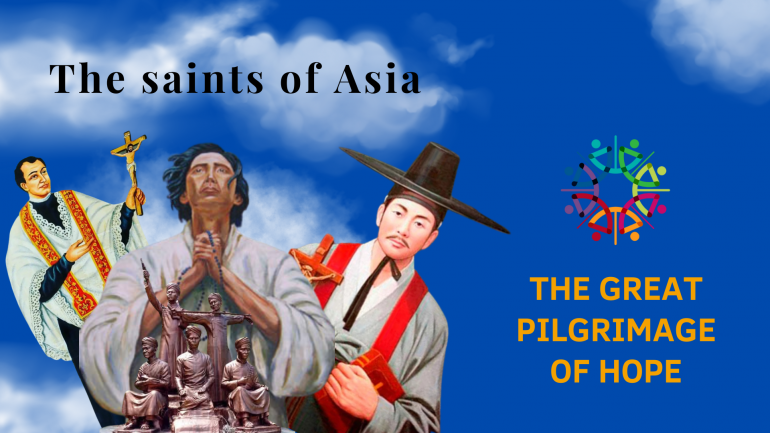Faith in Local Colours: The Great Pilgrimage of Hope

The story of Jesus has travelled far from the hills of Judea. In Asia, it has taken on new landscapes, the rice fields of the Philippines, the coconut groves of Kerala, the longhouses of Borneo, and the packed tuk-tuks of Bangkok. Yet in every place, the story is retold not in the accents of ancient Palestine but in the gentle tones, gestures, and rhythms of Asian hearts.
When the Gospel first touched Asian soil, it did not seek to erase what it found. It met ancient civilisations, mountain monasteries, and incense-scented temples where prayers had long risen to the heavens, where Asian bells had already tolled their acclamation of the divine. The Gospel found people already searching for truth, beauty, and transcendence. In that sense, the Gospel was never a foreign invader, it was a divine breath awakening something already within us in Asia.
Faith Must Wear Local Colours
To be Catholic in Asia today is not to mimic Rome or Jerusalem, but to live the Gospel in our own skin. It means wearing the cross with the costumes of our ancestors, like the Sisters of Charity of Mother Teresa, in their simple white cotton sari with three blue stripes, singing the Gloria in the Bengali dialect, and seeing Christ’s face reflected in their neighbours of every faith.
Pope St. John Paul II, in Ecclesia in Asia, said it best: “Jesus Christ is the Asian face of the invisible God.” If so, then our task is to make that face visible in our cultures, not by repainting Asia in Western hues, but by letting the Gospel breathe through our music, art, food, and family life.
This is the challenge of inculturation. As the late Pope wrote, “The Christian faith, while remaining completely faithful to the Gospel, must become truly inserted into each culture.”
That insertion is already happening in ways both subtle and profound. We see it in the Sinulog of the Philippines, in the Gawai and Kaamatan harvest festivals of Borneo, and in the vibrant Catholic liturgies of Indonesia. These are not embellishments, they are revelations of how the Gospel finds a home in Asian soil.
Faith as Story and Encounter
Asia has always been a continent of storytellers. Long before catechisms or theological treatises, wisdom flowed through myths, parables, and proverbs. It is no wonder that the Gospel, too, came as a story of a man who healed, forgave, and ate with the outcast.
The Indian Jesuit Anthony de Mello once wrote, “Behold God not in the cloud but in every human being that walks the earth.” That line captures the Asian intuition that God is found in the ordinary, in the market vendor, the farmer, the teacher, in the very cultures of the continent. To live the Gospel here is not so much to argue doctrine as to embody compassion.
Asia is a mosaic of faiths, comprising Hinduism, Buddhism, Islam, Taoism, and numerous indigenous beliefs. In this plural landscape, living the Gospel is about dialogue, relationship, and mutual respect.
Mahatma Gandhi once said, “My life is my message.” His words echo the heart of Christian witness in Asia, that the best sermon is a life lived with love. Pope Francis calls us to the same simplicity: to be “shepherds who smell like the sheep.” The Church here must be a Church that walks, not dominates; that listens, not lectures.
In Malaysia, for example, most often the service of the Church is quiet accompaniment, visiting the sick, helping flood victims, feeding migrant workers. These gestures do not make headlines, but they make the Gospel credible.
The Cross in Asian Light
Asia knows suffering. From war and persecution to natural disasters and poverty, the continent has seen its share of pain. Though suffering leads to despair, it has also deepened compassion. The Cross makes sense in Asia because it mirrors our collective story of endurance and mercy.
The saints of Asia, Andrew Kim Taegon, Lorenzo Ruiz, Joseph Vaz, and St. Philip Minh and Companions, were not conquerors but companions. Their holiness was born of service, patience, and fidelity. They show that sanctity in Asia is quiet, communal, and deeply human.
If institutions often shape the Western Church, the Asian Church is shaped by families. It is built not by power but by presence, by catechists, nurses, farmers, teachers, and journalists who live the Gospel in the ordinary.
For Catholics in Asia, faith must have feet, to walk among the poor, to heal the broken, and to bridge divided hearts. To live the Gospel here is not to escape into sanctuaries, but to bring holiness into the marketplace, the classroom, and the field.
The Gospel’s Asian Future
Asia today stands at a crossroads: between tradition and modernity, between digital culture and spiritual hunger. It is easy for faith to feel like an afterthought in an age of screens and speed. But perhaps this is the moment when the Asian Church must reclaim her prophetic voice, not to impose, but to inspire; not to shout, but to shine.
The dream of an Asian Christianity is not uniformity, but harmony. It is a Church that wears local colours yet speaks the universal truth of love. It is a Church where an Indonesian girl prays the rosary in Bahasa Indonesia, a Dayak mother reads the Bible in her native Bidahyu, and a Japanese Catholic bows before the tabernacle as she once bowed before the emperor, both gestures of reverence, both gestures of faith.
The Gospel did not come to change Asia’s heart; it came to reveal its heartbeat. Christ has always been here, in the rhythm of the monsoon, the song of the temple bell, and the echo of the conch shell, waiting, as He always does, not to be introduced, but to be recognised.








